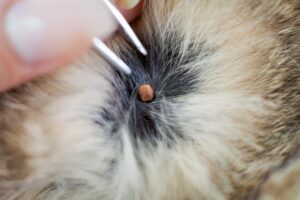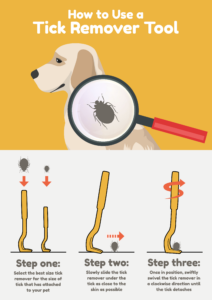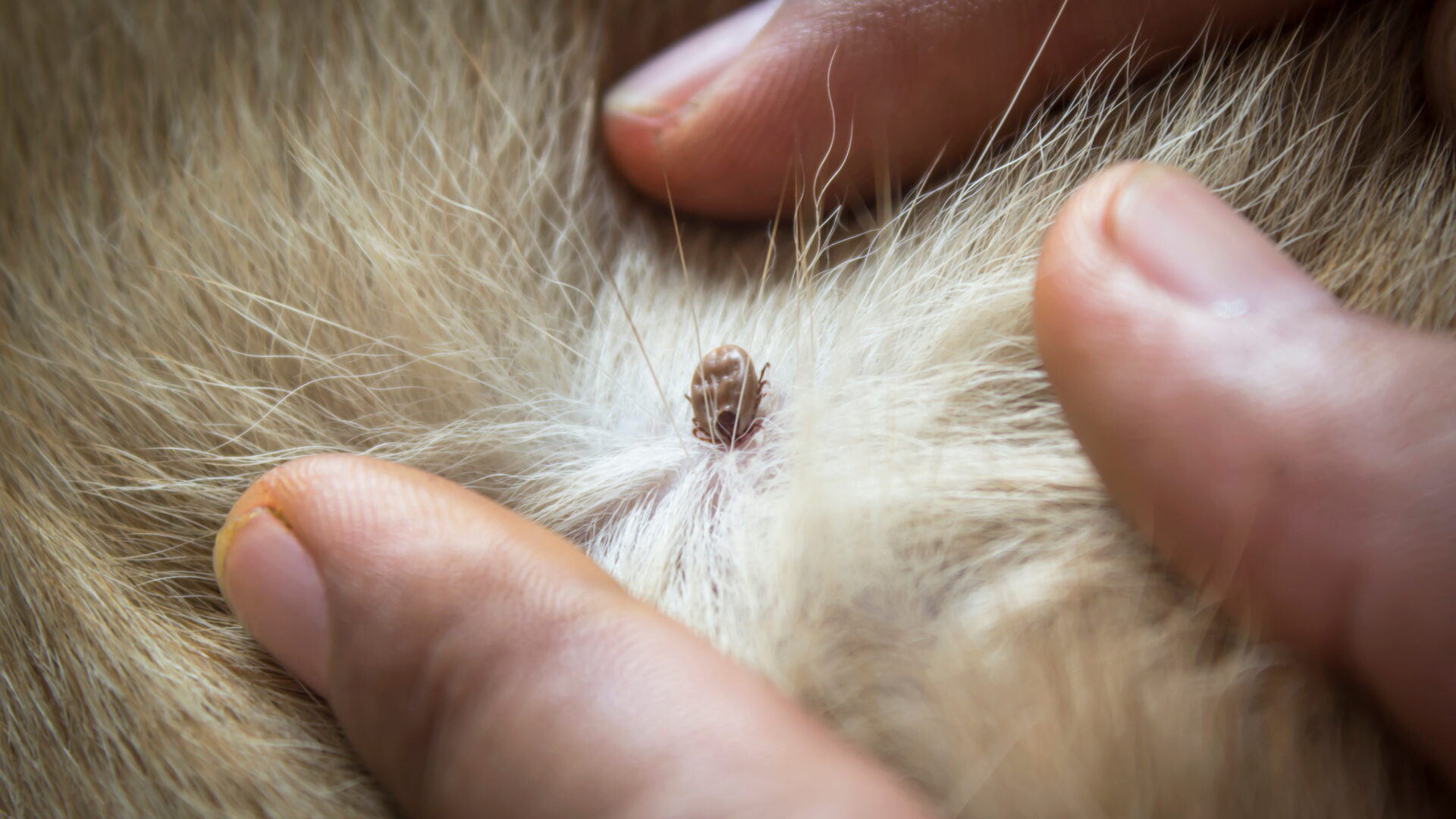Updated: 21/08/2024
Ticks are parasites that attach to a dog’s skin and feed on their blood.
They tend to be found in grassy or wooded areas and can be active all year, especially between spring and autumn.
Live ticks should be removed promptly – you can do this yourself if you are confident in the correct technique, or you can contact your vet for help.
If you’re worried about your dog or would like more information about the best preventative products for ticks, please speak to your vet.
On this page:
- What are ticks?
- Where do ticks come from?
- Why are ticks a concern?
- Which diseases can be spread by ticks?
- How to check for ticks?
- What to do if I find a tick on my dog?
- Tick treatment for your dog
- Tick protection when travelling abroad
- Can ticks affect humans?
What are ticks?
Ticks are small, red-brown parasites that become grey after feeding on your dog. They can be seen with the naked eye.
Adults have eight legs (whereas their young, nymphs, have six) and they are a type of arachnid (distantly related to spiders).
Ticks attach to your dog’s skin and feed on their blood. They can vary in size, from just visible with the naked eye up to about 1 cm.
As they feed on your dog’s blood, they expand (a bit like a balloon), and this is often when you are more likely to notice them.
Not only is this unpleasant for your dog (and perhaps you!), but ticks can also carry certain potentially serious diseases.
Where do ticks come from?
Ticks tend to be found in grassy or wooded areas grazed by sheep or where deer and other wildlife live.
They may also be present in your garden if you have lots of wildlife passing through.
Ticks wait on foliage to be picked up in your dog’s coat, and then find a place on the skin to attach.
They are mostly seen between spring and autumn, but are present all year round.
It’s an unpleasant thought, but they are not fussy about the type of animals they attach to – so keep your ankles covered when out walking in long grass, too!
Why are ticks a concern?
Apart from being horrible little critters, ticks may pass infections on to our dogs.
Although uncommon, some of these infections, such as Lyme disease and babesiosis, can be serious.
These diseases are caught when ticks carrying the infection bite our dogs to feed on their blood. Once they have consumed enough blood, they detach again and fall off.
Not all ticks carry diseases, and some geographical areas, such as the Scottish Highlands and Southern England, are considered higher risk than others.
Diseases which can be spread by ticks
Lyme disease
A nasty bacterial infection which can cause decreased appetite, low energy, a temperature, swollen lymph nodes, lameness and sore joints.
Anaplasmosis
This disease is caused by bacteria that can be transmitted by ticks. Often, dogs with this infection will show mild to no signs.
However, more severe signs can be seen and often include a fever, low energy, poor appetite, sore joints, neck pain and swollen lymph nodes.
Babesiosis
This is thankfully uncommon in the UK, but is becoming more of a concern with increased pet travel abroad.
The ticks that spread this disease are mainly found in Southern England and parts of Europe.
Signs of babesiosis include low energy, reduced appetite, a temperature, pale gums and abnormally dark urine.
Ehrlichiosis
Ehrlichiosis is rare in the UK, however, with increased pet travel, it is possible that dogs could return from abroad carrying ticks infected with this disease, which could then pass the disease to others.
Signs may be variable but can include fever, low energy, poor appetite and swollen lymph nodes.
Sometimes dogs can carry this infection with no signs for months to years.
Although currently the type of tick which carries this disease is unlikely to establish itself in the UK with the current climate, global warming may change this in future.
If your dog is unwell or has any of these symptoms, speak to your vet. Make them aware if your dog has also recently been bitten by a tick or walks in higher risk tick areas.
How do I check for ticks?
It is sensible to regularly check your dog for ticks (especially if they have a long coat).
Ticks can sometimes be mistaken for a small lump, nipple or skin tag.
When they attach, they embed tightly, and as they feed, their swollen body is the main thing you can see.

Sometimes the surrounding skin will look pink or a little swollen. Checking your dog regularly by running your hands through their coat is the best way to check for anything that feels different to normal.
Around the head, ears, armpits and feet are common areas that ticks attach to, but you can find them anywhere on your dog.
If you find what you suspect is a tick, but aren’t sure, your local veterinary practice will be happy to look for you and are well-practised in tick removal!
What do I do if I find a tick on my dog?
Once noticed, ticks should be removed promptly.
It is possible to remove a tick yourself if you are confident in the correct technique.
If you have not removed a tick before and are unsure what to do, then contact your vet for further support. They will be happy to show you how to remove a tick correctly.
Considerations when removing a tick:
When removing a tick, you need to avoid:
- Squeezing or distressing the tick (for example, by burning it or smothering it with cream or oil), as this may force blood out of the tick and back into your dog, which increases the risk of transferring any infections the tick carries.
- Accidentally leaving the head or mouthparts behind, as this can result in local irritation and possible infection.
Twisting ticks to remove them is safer and more effective than pulling them. It is possible to buy specific tick removal tools to make twisting them off much more straightforward.
General technique for using a tick remover:

- Part the hair around the tick so you can see what you are doing.
- Slowly slide the tick remover under the tick as close to the skin as possible.
- Once in position, swiftly swivel the remover in a clockwise direction until the tick detaches.
- Squish the tick in some tissue to ensure it can’t reattach. Hygienically dispose of it before washing your hands.
- Check your dog’s skin where the tick was attached to make sure the tick was fully removed and there’s no obvious bits left behind.
Tick treatment for dogs – How do I protect my dog?
If you are concerned that you live in an area where your dog is at risk of picking up ticks, it is a good idea to discuss this with your vet.
Similarly, if you live in a low-risk tick area but have plans to visit a higher risk area with your dog (for example, Scotland, the Lake District or Southern England), it is sensible to plan for this in advance.
Make sure your dog is treated with an appropriate product and that you know how to check your dog for ticks after walks and safely remove them if required.
Your vet will be able to advise on the most appropriate product to use, considering your dog’s individual situation, and can talk you through removing ticks safely.
Travelling abroad and tick protection
If you are planning on taking your dog on holiday abroad with you, it is worth considering that ticks in other countries may pose an increased risk or carry different diseases.
This is something to discuss with your vet before you go, to ensure your dog is adequately protected.
Do ticks pose a risk to human health?
Unfortunately, humans can catch Lyme disease much the same way as our canine companions.
Fortunately, only a small number of ticks carry Lyme disease, with areas such as the Scottish Highlands and Southern England posing a higher risk.
When walking dogs through grassy or wooded areas, it is important to take precautions such as keeping your legs covered, using insect repellent and walking on paths rather than through foliage wherever possible.
The Forestry and Land Scotland website has some helpful advice on how you can check for ticks.
Lyme disease can be serious, so if you visit high-risk tick areas or have been bitten by a tick and become unwell with a rash or flu-like symptoms, contact your doctor early for advice.
If you need any help or are concerned that your dog has a tick or seems unwell, please reach out to your local vets for further support.

